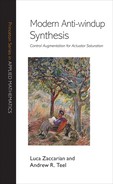Book Description
This book provides a wide variety of state-space--based numerical algorithms for the synthesis of feedback algorithms for linear systems with input saturation. Specifically, it addresses and solves the anti-windup problem, presenting the objectives and terminology of the problem, the mathematical tools behind anti-windup algorithms, and more than twenty algorithms for anti-windup synthesis, illustrated with examples. Luca Zaccarian and Andrew Teel's modern method--combining a state-space approach with algorithms generated by solving linear matrix inequalities--treats MIMO and SISO systems with equal ease. The book, aimed at control engineers as well as graduate students, ranges from very simple anti-windup construction to sophisticated anti-windup algorithms for nonlinear systems.
- Describes the fundamental objectives and principles behind anti-windup synthesis for control systems with actuator saturation
- Takes a modern, state-space approach to synthesis that applies to both SISO and MIMO systems
- Presents algorithms as linear matrix inequalities that can be readily solved with widely available software
- Explains mathematical concepts that motivate synthesis algorithms
- Uses nonlinear performance curves to quantify performance relative to disturbances of varying magnitudes
- Includes anti-windup algorithms for a class of Euler-Lagrange nonlinear systems
- Traces the history of anti-windup research through an extensive annotated bibliography
Table of Contents
- Cover Page
- Title Page
- Copyright Page
- Contents
- Preface
- Algorithms Summary
- Part I. Prepartion
- Part II. Direct Linear Anti-Windup Augmentation
- Part III. Model Recovery Anti-Windup Augmentation
- Index
